“Coco” animator discusses character design
Earlier this month, Christian Hoffman, character supervisor on Disney Pixar’s “Coco”, came to the Cleveland Institute of Art to speak with students about animation.
Christian Hoffman, the character supervisor for Pixar’s upcoming film “Coco,” spoke at the Cleveland Institute of Art (CIA) as a part of the Pixar Coco College Tour on Monday, Nov. 6.
He provided the audience with a glimpse at his work animating the characters in the film, releasing Nov. 22. Hoffman joined the company in 1996 where he has worked on beloved films such as “A Bug’s Life,” “Monsters Inc.” and “The Incredibles.”
“Coco” tells the story of Miguel, a 12-year-old boy who dreams of becoming a professional musician like his idol, Ernesto de la Cruz. However, his family forbids him to play music on the Day of the Dead—the time of year when the living and dead meet— so he visits de la Cruz’s grave to ask for a favor, launching himself on an incredible journey through the land of the dead.
The filmmaking process began in 2010 when the director, Lee Unkrich, and other members of the production team took research trips to Mexico in order to find inspiration. Participating in Day of the Dead celebrations, meeting Mexican families and seeing a shoe workshop helped them capture many aspects of Mexican culture they wanted to showcase in the film.
The cities they visited, such as Oaxaca, inspired the fictional village of Santa Cecilia where Miguel and his family live.
Although he was the character supervisor on “Coco”, most of Hoffman’s experience at Pixar has been working on rigging for the characters, which helps animate movement, beginning with each character’s skeleton.
“Rigging is just the process of positioning all those [technical] controls and then figuring out how those bind to the flesh and how the flesh moves,” said Hoffman during the presentation.
It was Hoffman’s experience in rigging that allowed him to fulfill his job as character supervisor for “Coco.” It was his second time in the role, the first being 2013’s “Monsters University.”
Although he does not get to work on the “juicy characters” anymore, Hoffman did develop the rig used for Miguel’s guitar strings.
“I get the little tiny things that are slipping through the cracks,” he said.
When Hoffman first entered the field, he was able to use his computer science background from Carnegie Mellon University in his past projects at Pixar.
When he first began working for Pixar, the company had its own proprietary code called “muddle code,” which Hoffman had to use when moving the characters. Later in his career he also used code to create the stretchiness of Helen’s limbs for “The Incredibles.”
“Now there is a department that writes the code for the characters,” he said to the audience. “I’ve relied less and less on my computer science background. We evaluate the needs of the film and ask [the coding team] to do it,”.
Hoffman spoke extensively about the rigging and animation in “Coco”, and the different issues and obstacles his team faced. One of those problems was animating Abuelita’s skin.
In the film, Miguel has an overbearing grandmother, Abuelita, who is the primary obstacle between him and his music. In order to accurately animate her movements, live subjects were brought in to be studied.
The women who came to the studio were asked to walk and move so that the team could watch how skin moves once it loses some of its elasticity. Hoffman and his team then used that information to create a rig for Abuelita’s skin, especially around her neck and on her underarms.
Hoffman also helped resolve another character issue, regarding the way the film portrays the degree to which a skeleton character is remembered by those in the land of the living.
Hoffman had a member of his team work with the art department for a month. There, he developed a system of shading the skeletons based on the premise that the more remembered you are, then “the whiter you are, the brighter you are, the more refreshed you are.”
“We put a lot of effort into this film, and … we hope that it shows on film, and that people are excited about it,” he said.


